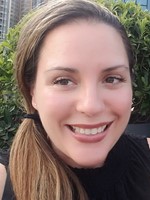Empathy Builders: Fifth Grade SEL Game Creation for First Graders
,
Colorado Convention Center, Bluebird Ballroom Lobby, Table 12
Presenters


Session description
Purpose & objective
Educational Challenge/Situation:
Educators are always looking for ways to weave in coding, design, physical computing, collaboration and in this presentation we will demonstrate how to do this in an SEL project for 4th -5th graders. In this session we will explain how we integrated plug and play coding, game creation and design, and use of a variety of materials to allow 4th-5th grade students to dive deeper into their own social emotional learning and create an interactive game to help first graders explore SEL concepts.
Technology Intervention:
We will share how students can use Scratch coding, Makey Makeys We will walk through the design, planning, building and testing process fifth grade student design teams followed to create their interactive games. Attendees will learn about the process, see student work, and discover new SEL learning outcomes and teaching techniques to energize their SEL instruction. The project we share can inspire more advanced opportunities for older learners and more teacher driven activities for younger students.
Models Employed:
Physical games created by students, examples of the coding they created in Scratch, etc.
Lesson Plans, Instructional Activities, etc.
Goal:
The goal of this project is to bring together several ideas and mindsets.
Fifth graders focus on their collaboration skills by working in small groups to plan, design, test and build and to also think about the idea of design groups and about the different skills that each student has and focus on that job. For example each group should have a coder, a designer/artist, and a game board builder. They will test and make any changes to their design to ensure they have working code, an engaging game and a functioning wired game board.
The second goal of this project is for students to think about how to design or create something for a specific audience. For this project, fifth graders design an interactive game for first graders. Students will be thinking about a first grade audience and design a game for seven year olds to play. The focus of the game will be emotions and understanding emotions and the SEL topic from the first grade RULER curriculum. They will need to think about what graphics would be appealing to a first grade audience. They will also need to make sure that the game they design is something that a first grader can do, thinking about the reading level or a first grader, the size and abilities of a seven year old and try and make a game that would be fun and engaging for that age group.
The final goal is SEL. Fifth graders will be using the feeling and mood meter connected to the first grade curriculum to design and make the games for their first grader users. In order for fifth graders to be able to make a game for someone else they will need to illustrate an understanding of the topic themselves. The goal of using this as a topic is to reinforce the ideas of emotions, reading emotions and being able to name your feelings for fifth graders and for them to illustrate their understanding of the topic in order to make successful games for first graders.
Timeline:
This is a five week project during the second grade ILIS rotation. Classes will come to ILIS twice a week for 40 minute sessions.
Week 1: Introduce project and put students into their groups. Talk about the different roles they have to assign to one another. By the end of class one, have jobs assigned and have the beginning of a design plan. Share out different samples of the games: Maze, Collection, and Avoid. They will choose which game they want to make.
They can pick the colors or each emotion out of the hat:
Yellow, Red, Green, Blue, and they can pick one emotion or use a range to create their game.
Jobs:
Coder: responsible for the code in Scratch, checking in with the graphic designer to collect all the art and images to use in the game, and checking in with the electrician/engineer to make sure the code is working with the wiring and the game board.
Graphic Designer or Art Designer (background images, find pictures that go on the game board or in the game) check in with the coder to make sure they have all the images and art they need and with the engineer to make sure they have all the art they need for the game board
Engineer/Electrician (build the board, wire the board, connect wires with Makey/Makey) Pool Noodle, Foot Movement, Placement, Checking in with the coder to make sure the code works with the Makey/Makey and wires for directional movements and checking in with the graphic designer to make sure they have the art they need to complete the game board.
Week 2: continue building and making games
Week 3: continue building and making games- start testing and making changes to their games
Week 4: Taft - no classes
Week 5: first session: final building/changes, second session: share out of all their games with each other
Reach out to the first grade and the fifth grade teachers to set up times for each class to come to the library and share their games with the first graders and get feedback from first graders about their games and what they learned about the different emotions and SEL concepts.
Resources:
Scratch Resources slide deck
Sample catch game
Sample Maze game
Sample Avoid Game
Materials:
-Makey Makeys- Make sure we have enough and they are set up the right way (L,R,Up, Down arrows) 40
-Conductive Material: foil, PEEL AND STICK COPPER SHEETS,
-Wire
-Pool Noodles
-Duct tape
Outline
Games will be available for participants to try. 10 Minutes
Introduction to the process 10 Minutes
Overview of collaboration of the SEL project with teachers 10 Minutes
Reflections on the students process, documentation of the student process 10 Minutes
Share examples of the physical games for participants to interact with, as well as sharing of resources and Q&A: 20 Minutes
Process: In this Ed Tech Talk, audience will interact with student examples, play the games, and hear how the games were created through the process above.
Supporting research
https://www.rulerapproach.org/about/what-is-the-evidence/
https://mres.medium.com/computational-fluency-776143c8d725
https://bcpslis.pbworks.com/w/file/fetch/133279062/Collaborate.pdf
https://files.eric.ed.gov/fulltext/EJ1099478.pdf
Session specifications
Innovative Designer
- Students know and use a deliberate design process for generating ideas, testing theories, creating innovative artifacts or solving authentic problems.
- Students choose the appropriate platforms and tools for meeting the desired objectives of their creation or communication.
- Students communicate complex ideas clearly and effectively by creating or using a variety of digital objects such as visualizations, models or simulations.
 Return
Return Participate and share: Poster
Participate and share: Poster  Trips and Tours
Trips and Tours